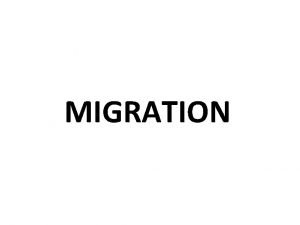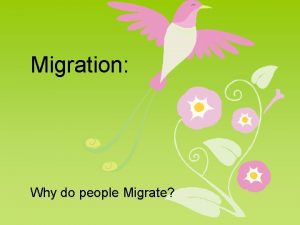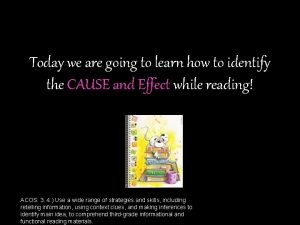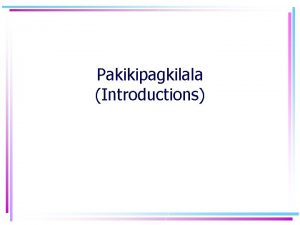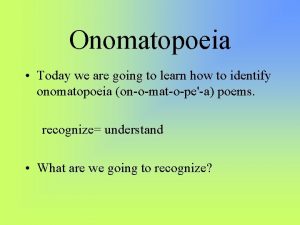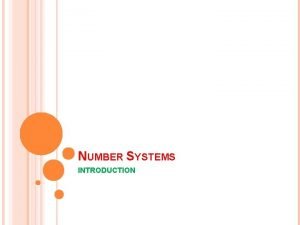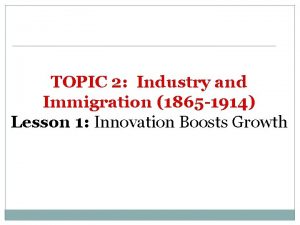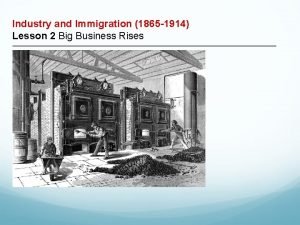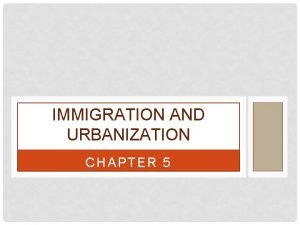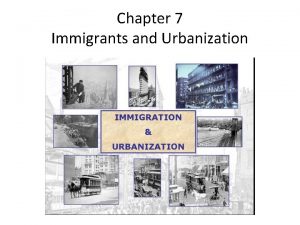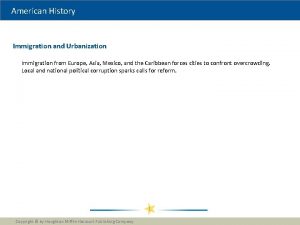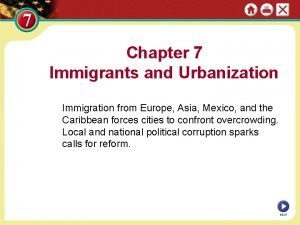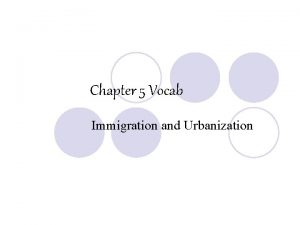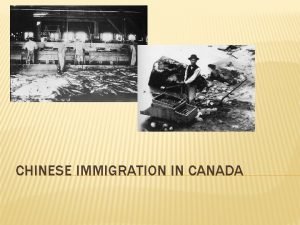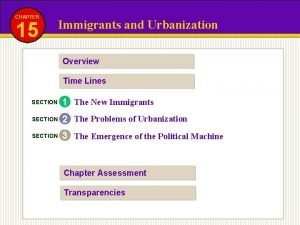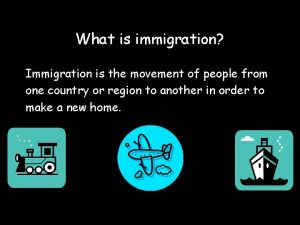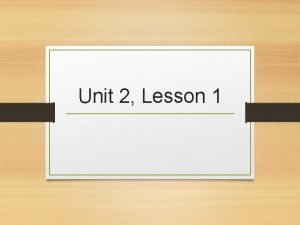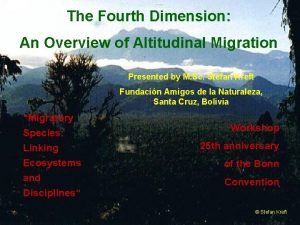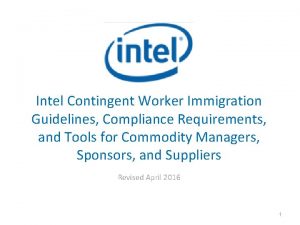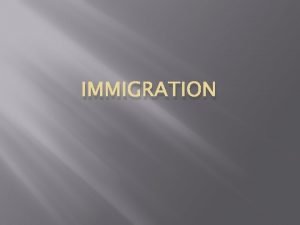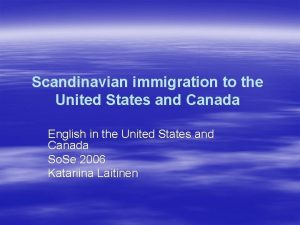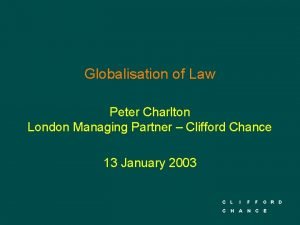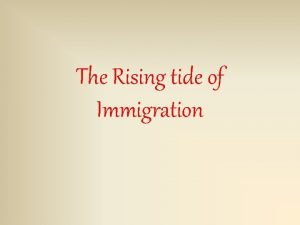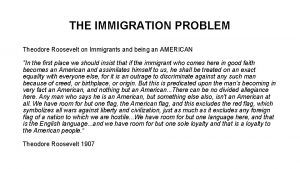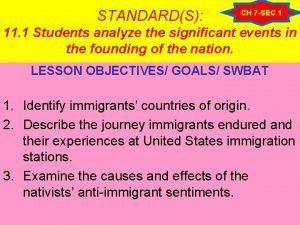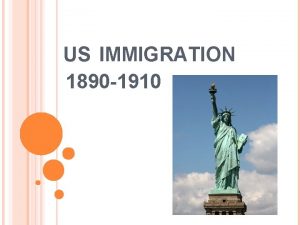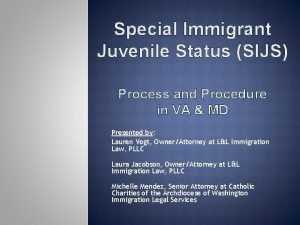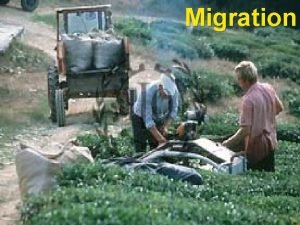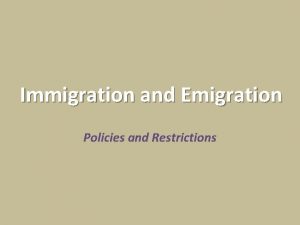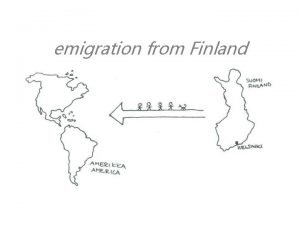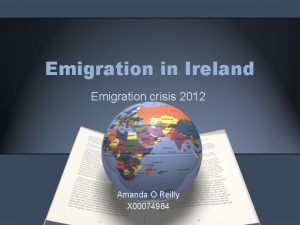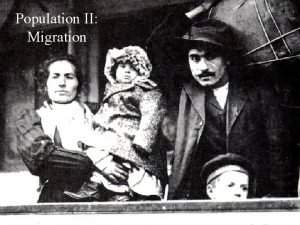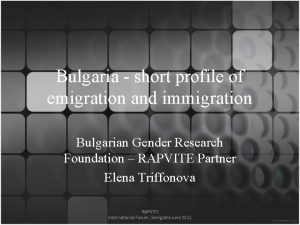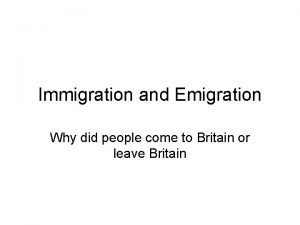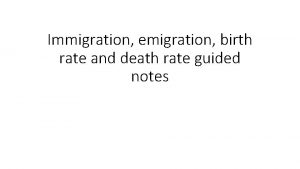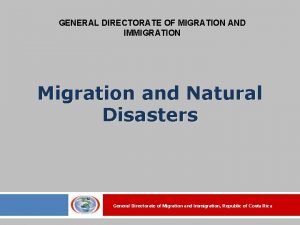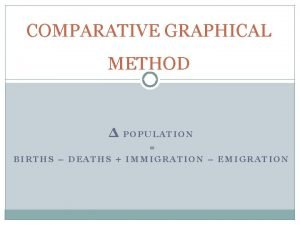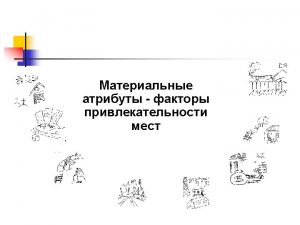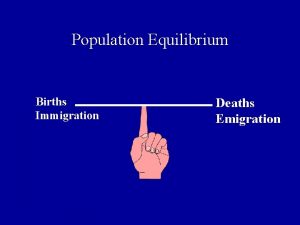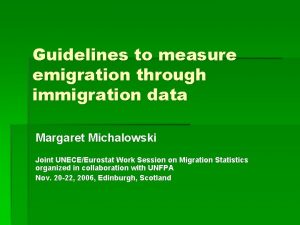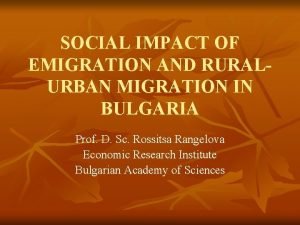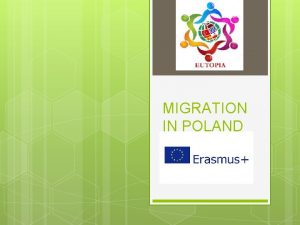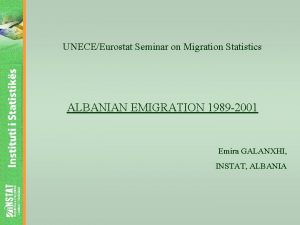Migration immigration and emigration Today we will learn
























































- Slides: 56

Migration, immigration and emigration. Today we will learn how L/O: To examine impact of migration in a local and global context? F/O: I can listen with focus to extended inputs and synthesise key features. My response is insightful and assured.



Human Migration Patterns • Human migration A person leaving to go to a new place or residence for social, economic or political reasons resulting with different effects.

Immigration= coming in to a country • Immigration defines the movement of people (between) countries. • The movement of people has existed throughout history at various levels. • The emergence of nationstates made immigration a political issue.

Emigration= leaving a country Emigration is the act of leaving one's native country or region to settle in another. It is similar to immigration but, begins from the of the country of origin. Human movement before the establishment of state boundaries or within one state, is termed migration.

Definitions • Refugee can be defined as someone in fear of being persecuted for reasons of race, religion, nationality, membership of a particular social group, or political opinion. Refugees seek protection from another country.

Globalization and Migration • Now that we have defined various migration terms • Have discussed transnationalism • Have discussed the push/pull forces of globalization… • Lets list on the board some of the causes of migration!!!

Migrants • From pre-colonial times, we have always been migrants. • From slave labor in the early part of the 19 th century • To labor movement today

Migration • Internal Migration – within national borders • Transnational Migration – back and forth • Push-Pull Factors Types of Migrants • Labor • Displaced • Refuges – internationally displaced • IDPs – internally displaced persons

Migration Types Institutional Migrants • people who voluntarily move into a social institutional • students, solders, nuns, monks, etc. New Immigrants • term applies to people who have migrated since the 1960 s Globalization – has increased diversity It has lead to acceleration – of the quantitative growth of populations. Feminization – growing role of women Chain Migration – following others (often families)

Background • In the US, anthropologists have for generations viewed immigrants as people who uproot themselves, leaving behind home and country, and face the painful process of incorporation into a different society and sometimes culture

Transmigrants • Transmigrants are immigrants whose daily lives depend on multiple and constant interconnections across international borders and whose public identities are configured in relationship to more than one nation-state e. g duel nationality.

Transnationalism Not a new term, first cited in 1916 by American writer Randolph Bourne in his paper “Trans-National America” describing what today we would call “multiculturalism” In the context of migration term was first used in 1990 s

What is Transnationalism? • Transnationalism, as defined by Basch et al (1994) is “a process by which migrants, through their daily life activities create social links that cross national boundaries” • Long-distance politics: Cuban population in Florida advocating for the fall of communism in Cuba • Sometimes transnational populations are exile or opposition groups. • Dual citizenship/nationality– marked global upward trend in claims through naturalization, marriage and birth, widespread government policy shifts

Transnationalism and Globalizaton • Globalization aids the intensification of worldwide social relations. This links distant localities in such a way that local happenings are shaped by events occurring many miles away and vice versa. • Transfer of cultural practices • Example: How sushi went global

Causes of Displacement • Involuntary migrants – Displaced by force or some sort, including economic • Voluntary migrants – Mostly those who migrate for work

Discussion Questions • What are some of the effects of displacement on refugee populations? • What are some of the health effects of displacement on refugee populations?


Immigration Movement of labor and people

Brain Circulation What is brain drain? What is brain circulation? What is an ethnic professional association? What do they seek to accomplish? How could such associations act to hinder a start-up over time? What does the Saxenian say the US offers in terms of industry growth? What does Taiwan offer? What are some possible problems with US companies using industry in developing countries (ie: buying parts/software)? What are some possible gains for developing countries sending their technologically advanced workers to the US? Similarities between Saxenian’s and Friedman’s models of globalization? Why are production costs lower in Taiwan? It all comes back to labor…

Labor Conditions in Taiwan There are labor laws on the books (Labor Standards Act) but… There are 160, 000 migrant workers serving in domestic sector in Taiwan. However, they are excluded from the Labor Standards Act and don't have any right to holiday nor extra payment for overtime work. Two migrant workers related their sad experience working in the country in a press conference held by Chinese Nationalist Party (KMT) Legislator Joanna Lei. Aming stated: "I have been sold [by brokers] to six different employers since coming to Taiwan and my identification card has been confiscated. ”





Social Groups Social Stratification Illegal Immigration

Social Groups Social group – cluster of people beyond the domestic group (home/family) related on in ways other than kinship Primary Group – people know one another personally Secondary Group – identify together but may never meet Unsurprisingly, complex societies have more groups than small societies. A main organizing group in many cultures is the Age Set Most of you belong to the same age set, which is a meaningful group in anthropological thought

Social Groups Friendship A form of primary social group Is it a cultural universal? Well… Friendship is often defined by whom you feel comfortable/safe discussing secrets with Limiting factors to forming friendship include Social environment – gender – class – religion – economic status Common aspects of friendship Sharing of resources – storytelling – sharing leisure time

Social Groups Clubs and Fraternities • Typically organized to reinforce certain protocols, attitudes, backgrounds, etc. • gynophobic – women-hating or otherwise antiwomen groups • homophobic – fear and/or distrust of homosexuals • xenophobic – dislike and/or fear of people from other countries

Social Groups Countercultural Groups • Youth Gangs – often considered a problem by adults and law enforcement – however, many form in response to social and economic pressures • Common myths – – members come from broken homes – males join to replace missing father figure

Social Groups Countercultural Groups Cooperatives – form to enhance production, consumption, or exchange Farmer’s Cooperatives – allows small farmers to work together in order to compete with multinational groups (Fair Trade Coops) Craft Cooperatives – allows small producers to avoid costly middle-men

Craft Cooperatives According to the US Congressional Capper-Volstead Act of 1922: “A cooperative consists of persons engaged in production, processing, preparing for market, or handling commerce acting together that these actions are in the mutual benefit of members” (Torgerson, 1990). Cooperatives must conform to two basic requirements: (1) each member has one vote, regardless of amount of stock or membership capital, and (2) non-member products shall not exceed the value of member products (Rasmussen, 1991).

Social Stratification Ascription (Ascribed Status)– membership on the basis of birth race – ethnicity – gender – caste Race vs. Ethnicity Race – anthropologies role and subsequent apologetic stance in using ‘race’ as an organizing concept Don’t forget Franz Boas – the Hero of Cultural Relativism – culture is the MOST important factor in determining behavior (NOT BIOLOGY!!!) CULTURE IS NOT GENETIC!! IT IS LEARNED!!! Ethnicity – a sense of group membership based on a common cultural identity

Social Stratification Ethnicity • Ethnic Minorities in China • The People's Republic of China (PRC) officially recognizes 56 distinct ethnic groups, the largest of which are Han Chinese, which constitutes about 91. 9% of the total population. • The 55 other ethnic groups are officially recognized as ethnic minority groups. • Minority population grows faster than that of the majority Han Chinese, in 1953 at 6. 1%, in 1990 at 8. 04%, in 2000 at 8. 41%, and in 2005 at 9. 44%. • In the most recent survey, their population growth is about seven times faster than that of the Han Chinese. • That is because the "One child policy” only applies to the majority Han Chinese

NATIVE TRIBES, GROUPS, DIALECTS AND FAMILES OF CALIFORNIA IN 1770 • ATHABASCAN FAMILY • ALGONKIN FAMILY • • • OREGON GROUP ROGUE RIVER TOLOWA GROUP TOLOWA HUPA GROUP HUPA CHILULA WHILIKUT MATTOLE GROUP MATTOLE WAILAKI GROUP WAILAKI • • • YUROK COAST YUROK WIYOT YUKIAN FAMILY YUKI HUCHNOM COAST YUKI WAPPO MODOC (NOW INCORPORATED IN THE PENUTIAN FAMILY)

HOKAN FAMILY • • • • • • SHASTAN SHASTA NEW RIVER SHASTA KONOMIHU OKWANUCHU ACHOMAWI (PIT RIVER) ATSUGEWI (HAT CREEK) YANA NORTHERN YANA CENTRAL YANA SOUTHERN YANA YAHI KAROK CHIMARIKO POMO NOTHERN CENTRAL EASTERN SOUTHEASTERN NORTHEASTERN SOUTHWESTERN • • • • • • WASHO ESALEN SALINIEN ANTONIANO MIGUELENO PLAYANO CHUMASH OBISPENO PURISMENO YNEZENO BARBARENO VENTURENO EMIGDIANO INTERIOR ISLAND YUMAN NORTHERN (WESTERN) DIGUENO SOUTHERN (EASTERN) DIGUENO KAMIA YUMA HALCHIDHOMA (NOW CHEMEHUVI) MOHAVE

More Language Families PENUTIAN FAMILY MODOC WINTUN DIALECT GROUPS NORTHERN CENTRAL (NOMLAKI) SOUTHEASTERN (PATWIN) SOUTHWESTERN (PATWIN) MAIDU DIALECT GROUPS NORTHEASTERN NORTHWESTERN SOUTHERN (NISENAN • • • • MIWOK COAST LAKE PLAINS NORTHERN CENTRAL SOUTHERN BAY MIWOK COSTANOAN SAN FRANCISCO SANTA CLARA SANTA CRUZ SAN JUAN BAUTISTA (MUTSUN) MONTEREY (RUMSEN) SOLEDAD YOKUTS

DIALECT GROUPS • • • • NORTHERN VALLEY (CHULAMNI, CHAUCHILA, ETC) SOUTHERN VALLEY (TACHI, YAUELMANI, ETC) NORTHERN HILL (CHUKCHANSI, ETC) KINGS RIVER (CHOINIMINI, ETC) TULE-KAWEH (YAUDANCHI, ETC) POSO CREEK (PALEEUYAMI) BUENA VISTA (TULAMNI, ETC) UTO-AZTEKAN (SHOSHONEAN) FAMILY PLATEAU BRANCH MONO-BANOCK GROUP NORTHERN PAIUTE (PAVIOTSO) EASTERN MONO (PAIUTE) WESTERN MONO SHOSHONI-COMMANCHE GROUP KOSO (PANAMINT SHOSHONE) CHEMEHUEVI (SOUTHERN PAIUTE) KAWAISU (TEHACHAPI) KERN RIVER BRANCH TUBATULAABAL (AND BANKALACHI) SOUTHERN CALIFORNIA BRANCH SERANO GROUP KITANEMUK (TEJON) ALLIKLIK VANYUME (MOHINEYAM) SERRANO GABRIELINO GROUP FERNANDENO GABRIELINO NICOLENO LUISENO - CAHUILLA GROUP JUANENO LUISENO CUPENO CAHUILLA MOUNTAIN CAHUILLA DESERT CAHUILLA PASS CAHUILLA


Social Stratification Types of Diaspora Populations • Jewish Diaspora as template for meaning • Victim Diasporas – African (Slave) Diaspora, Armenians, Chinese in Latin America Labor Diasporas – Indians and Chinese in Caribbean Imperial Diasporas – English in Australia, New Zealand, South Africa, and the US Trade Diasporas – Chinese in SE Asia, Lebanese in US and New Zealand Cultural Diasporas – creolized groups remigrating from Caribbean to US, England, etc.

Social Stratification Chinese Diaspora • Began migrating out of China 1, 000 years ago to SE Asia • 1800 s – begin migrating in large numbers outside of Asia • Heavily racial-ized minority by the late 1800 s around the world • Little know fact that the Chinese comprised a ‘Second Slave Trade’ to Latin America (1847 -1874) – 100, 000 to Peru – 125, 000+ to Cuba – 10, 000 s to Caribbean

Social Stratification 19 th Century Chinese Immigration to the US Perceptions of Threat in the West (beginning in 1840 s and 50 s) - taking jobs - corrupting white women (sound familiar? ) In the East (1870 s and on) - taking jobs - corrupting white women (trends…) In the Southeast (1870 s and on) - victims of ‘second’ slave trade - little threat

Social Stratification 19 th Century Chinese Immigration to the US – Exclusionary Laws • 1882 – barred Chinese from immigration for 10 years • 1892 – Geary act extended it for another 10 years • 1904 – made permanent by the Extension Act Political Value = halting immigration (protectionist) • Chinese immigration labeled a humane way to end what was termed a “Second Slave Trade” by many politicians based on SE US experience

Social Stratification 19 th Century Chinese Immigration to the US • Exclusionary Laws • Finally repealed in 1943 with the Geary Act • Political value = WWII, many Americans become sympathetic to Chinese fight against Japanese (of course, Japanese are stripped of rights at this time, internment camps and other abuses…)

Social Stratification 20 th Century Racializations of Chinese • 1943 Geary Act grants, in theory, all Chinese the right to become naturalized citizens, the experience is quite different. Chinese continue to exist as a heavily racial-ized ethnic group

Immigration Has Become Extraordinarily Contentious • US has about 20% of world’s total immigrants– 190 Million worldwide–Russian Federation 2 nd most • Nevertheless, largest ever in absolute numbers, approximately 36 Million • But not largest percentage–United Arab Republics has over 70%

Illegals / Undocumenteds About 25% of total immigration How many from Mexico? – 55 -60% 50, 000 Irish 500, 000 other Europeans About 40% enter legally as students, tourists, on business Most arrive on commercial carriers or come across Canadian border 9/11 hijackers entered legally

Immigrants and Jobs Consensus: Immigrants do not take jobs away from Americans Jobs Americans don’t want Create jobs Contention in some workplaces

Employer Enforcement • Cases resulting in fines very, very small – Both in the number of cases and the total fines • ICE increased enforcement past 3 years – Raids, pushes, etc • Cycles through the “illegal of the day” – Mexican, Hmong, Guatemalan, etc

Immigrants and Taxes Immigrants pay income, property, and taxes at the federal and state level The IRS has seen an increase in the number of tax returns filed using an Individual Tax Identification Number. The system originally was designed for people living abroad who had investments in the US. But it quickly is becoming used by undocumented workers who aren't eligible for Social Security numbers. In 2005, 1. 4 million people filed tax returns using the numbers. In 2002, illegal immigration added a net surplus of $463 billion to social security

Immigrants and Welfare Immigrants less likely than natives to use public services Just 2 percent of illegal Mexican immigrants had ever received welfare or Social Security payments and just 3 percent had ever accepted food stamps. The most-used service is emergency medical care and school, the first is used sparingly due to fears of being caught and the second is used through their children who are almost always American citizens.

Immigrants and Language • Within 10 years 75% speak English • Demand for English classes outstrips supply • Second generation often overwhelmingly prefers English and is completely acculturated • Is this true in your experience? Why/Why not? • The key to successful immigration is acceptance verse discrimination

Legal Immigration? • Average backlog 4 years • Backlog of 12 years for Mexico • For Mexican siblings of U. S. citizens, the government is just now getting to applications filed before July 1, 1992!!!!

Immigrants & Crime Immigrants lower crime rates – 1 stgeneration immigrants 45% less likely to commit violence than 3 rdgeneration Americans During 1990 s when immigration highest, crime dropped the most – Los Angeles it dropped 45% Why: motivation to work, ambition and desire not to be deported

Impacts of Immigrants • Consensus that they positively contribute economically • Assimilation complete with second generation • The most important factor in integration and assimilation is – NOT characteristics of immigrants – BUT how US natives treat immigrants
 Migration key terms
Migration key terms What is immigration
What is immigration Wilbur zelinsky ap human geography
Wilbur zelinsky ap human geography California emigration
California emigration Emigration ap human geography definition
Emigration ap human geography definition Kinesthetic learning
Kinesthetic learning Today we're going to learn
Today we're going to learn Learn today lead tomorrow
Learn today lead tomorrow Today we are going to learn
Today we are going to learn Today we are going to learn
Today we are going to learn Phrases of quantity food
Phrases of quantity food Pakikipagkilala
Pakikipagkilala Onomatopoeia in poems
Onomatopoeia in poems What will we learn today
What will we learn today For todays meeting
For todays meeting Do we have class today
Do we have class today Meeting objective
Meeting objective Characteristic of fingerprint
Characteristic of fingerprint Today's lesson or today lesson
Today's lesson or today lesson Today's lesson or today lesson
Today's lesson or today lesson Topic 2 industry and immigration
Topic 2 industry and immigration Industry and immigration lesson 5 a nation of cities
Industry and immigration lesson 5 a nation of cities Industry and immigration lesson 2
Industry and immigration lesson 2 Chapter 5 immigration and urbanization
Chapter 5 immigration and urbanization Chapter 7 building vocabulary immigration and urbanization
Chapter 7 building vocabulary immigration and urbanization Chapter 7 building vocabulary immigration and urbanization
Chapter 7 building vocabulary immigration and urbanization Transcontinent
Transcontinent Chapter 7 building vocabulary immigration and urbanization
Chapter 7 building vocabulary immigration and urbanization Chapter 5 immigration and urbanization
Chapter 5 immigration and urbanization Chinese immigration to canada push and pull factors
Chinese immigration to canada push and pull factors Chapter 15 building vocabulary immigration and urbanization
Chapter 15 building vocabulary immigration and urbanization What is the immigration
What is the immigration What is immigration
What is immigration How did esperanza help marta during an immigration sweep
How did esperanza help marta during an immigration sweep Fourth dimension immigration
Fourth dimension immigration Emmigration
Emmigration Lca in immigration
Lca in immigration Http://teacher.scholastic.com/activities/immigration/tour/
Http://teacher.scholastic.com/activities/immigration/tour/ Klasko immigration law partners llp
Klasko immigration law partners llp European immigration to texas
European immigration to texas Ucf
Ucf Immigration to the united states
Immigration to the united states Jennie ellis australia immigration
Jennie ellis australia immigration Italian immigration to scotland
Italian immigration to scotland Frank & delaney immigration law, llc
Frank & delaney immigration law, llc Immigration lawyer aifft
Immigration lawyer aifft Immigration lawyer charlton
Immigration lawyer charlton What is this
What is this Theodore roosevelt on immigrants
Theodore roosevelt on immigrants European immigration
European immigration Immigration
Immigration European immigration
European immigration What is the immigration
What is the immigration Sijs immigration
Sijs immigration Immigration presentation ideas
Immigration presentation ideas Compare and contrast community and ecosystem
Compare and contrast community and ecosystem Who were they
Who were they
